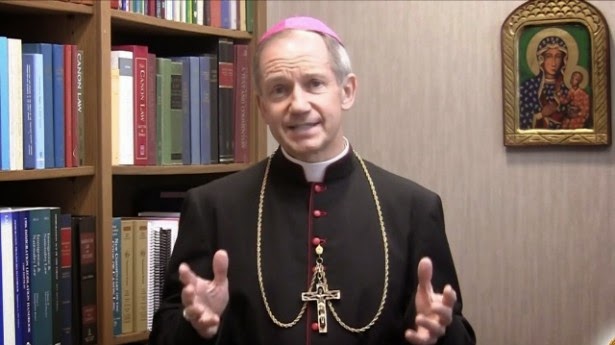Explicit Instructions Re: Tabernacle From Bishop of Illinois
Check out this brilliant Pastoral Letter from His Excellency Most Reverend Thomas John Paprocki, Bishop of Springfield in Illinois, Given at the Cathedral of the Immaculate Conception in Springfield, Illinois, on June 22, the Solemnity of Corpus Christi and the Feast Day of Saints Sir Thomas More and John Cardinal Fisher, this year (2014). In it, he investigates the work of Vatican II in continuity with the Tradition of the Church, and sets out a plan for moving forward in an inspiring and attractive way. This is a mandate for growth!
In it, Bishop Paprocki makes the following interesting observations:
- We must seek to be found fully aware of our actions in the presence of the Blessed Sacrament lest we fail to pay him the homage that is due him. This desire to come and adore the Lord must flow also into everything that pertains to the liturgical celebration of the Eucharist. (no. 12).
- The primary way to foster the participation of the People of God in the sacred rite is the proper celebration of the rite itself. (no. 12)
- Quoting the Curé of Ars: "The cause of priestly laxity is not paying attention to the Mass." (no. 14).
- Good point in no. 15: "The sense of the sacred is fostered by a reverent ars celebrandi, an art of celebrating, one of humble devotion, not of laxity or of rigidity."
Perhaps he read Fr. Ray Blake's excellent blog post from the other day, because he instructs his clergy & faithful as follows:
Over the past few decades, tabernacles all too often were moved from prominent places in the sanctuary to obscure and remote rooms that in some cases were previously supply closets.
The present legislation of the Church concerning the placement of the tabernacle states, "In accordance with the structure of each church and legitimate local customs, the Most Blessed Sacrament should be reserved in a tabernacle in a part of the church that is truly noble, prominent, conspicuous, worthily decorated, and suitable for prayer." (General Instruction of the Roman Missal, 314). Regrettably, this is not always followed.
In some churches and chapels, the tabernacle is set on a "side" altar in such a way that the tabernacle, though noble, is neither prominent nor readily visible. The same is often the case with the location of some Eucharistic chapels, whether they be in the nave itself, behind the sanctuary, or in another room. They are not always prominent or readily visible. (no.'s 18-20).
The Bishop goes on:
The great majority of our parish churches and chapels were designed to house the tabernacle in the center of the sanctuary; removing the tabernacle from these sanctuaries has left a visible emptiness within the sacred space, almost as though the building itself longed for the return of the tabernacle. With the removal of the tabernacle from the center of the sanctuary, the architectural integrity of many churches and chapels has been severely compromised.
His Excellency goes on to explain in the footnotes that the reason for this terrible mistake, was a misprint and transposition of numbers referenced in the Sacred Congregation for Rites' document, Eucharisticum Mysterium, May 25, 1967, (no. 54) as translated from Latin to English, which has led to the perpetuation in error of mistaken liturgical principles and incorrect architectural norms involved in the placement of the Eucharistic Tabernacle.
Bishop Paprocki directs his clergy to thus re-order their Churches, placing the Tabernacle at the centre:
I direct that in the churches and chapels of our diocese, tabernacles that were formerly in the center of the sanctuary, but have been moved, are to be returned as soon as possible to the center of the sanctuary in accord with the original architectural design. Tabernacles that are not in the center of the sanctuary or are otherwise not in a visible, prominent and noble space are to be moved to the center of the sanctuary; tabernacles that are not in the center of the sanctuary but are in a visible, prominent and noble space may remain. (no. 23).
Regularly scheduled times for exposition of the Most Holy Eucharist in a monstrance or pyx, as well as an annual solemn and lengthier exposition of the Most Blessed Sacrament, are highly commended as ways to stimulate the faithful to spiritual union with Christ which culminates in sacramental communion.
 |
| The centrally placed Tabernacle at the Cathedral of the Immaculate Conception. |
...all who pass before the Most Blessed Sacrament genuflect, unless they are moving in procession. Ministers carrying the processional cross or candles bow their heads instead of genuflecting.
When we genuflect before the Lord, our strength is not taken from us; rather, we willingly bend our strength to the Lord and place ourselves humbly in his service. When we bend our knee to the Lord of heaven and earth we should hear the words of the Psalmist ever in our hearts, "Lord, I am your servant," remembering that before the Lord every knee must bend (Psalm 116:16; cf. Philippians 2:10). (no.'s 29 & 30)Fantastic and an expression of the faith which is explicit in reasserting norms we should all be aware of. The thing is, things have gone so far now that many people are not aware. It's not their fault, they simply have never been taught this stuff. Certainly this applies to myself; I had to embrak on a voyage of reeducation and indeed, discovery, in order to re-invigorate my faith and re-dedicate my life to Christ. This is my journey of faith, and we are all on our own journey to some extent. This is why it is so important that our priests and bishops are explicit, just as Bishop Paprocki has been explicit here, about what constitutes a Catholic attitude and worship. Thank you Bishop Paprocki for this excellent Apostolic Letter!
He also says:
No. 8: Near the tabernacle the sanctuary lamp gently burns, kept alight to indicate and honor the presence of Christ and to call our attention to the Eucharist reserved in the tabernacle.6 There he waits for us. At times in our lives we ask with those two disciples, "Where are you staying" (John 1:38)? From his tabernacle he calls out to us: "Come, and you will see" (John 1:39).This is very similar to Fr. Kevin's words this past Corpus Christi, when he reminded his flock in Leigh-on-Sea that Jesus is always present in the Church, and that we should make time to visit him outside of Mass, as we would anyone we love.
Although I have to admit from an English perspective, that the Baseball analogy in no. 10 does not quite travel (although if I think of Cricket, I can understand where he is coming from), this letter is a valuable example of how we are rebuilding the Church from a foundational sense of what we are. The relativism of recent decades has eroded this certainty and replaced it with the idea that our behaviour, attitude, and even understanding no longer matter, because Jesus loves us. Although it is profoundly true that Jesus does indeed love us, the reality of love is communicated in the every action of the lover towards the beloved. Thus the Ars celebrandi et adorandi (the Art of Celebrating the Eucharistic Liturgy) is profoundly important for the Catholic faith. Lex Orandi, Lex Credendi, Lex Vivendi --How we pray determines what we believe and thus how we live.






Comments
Post a Comment